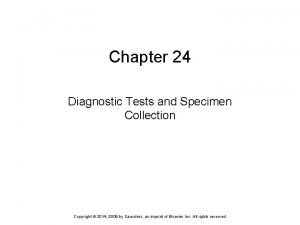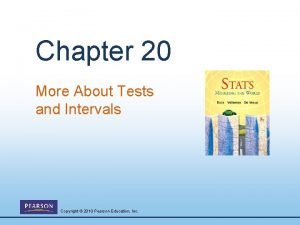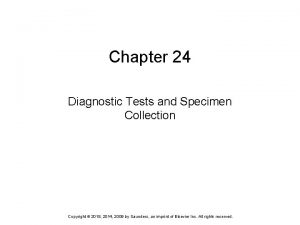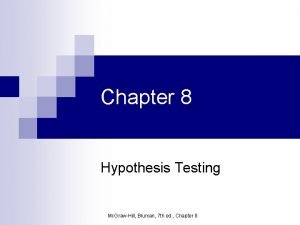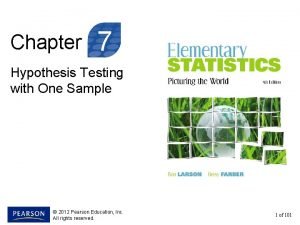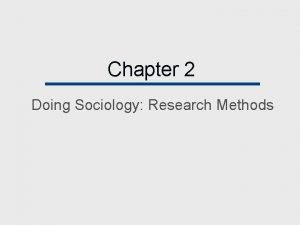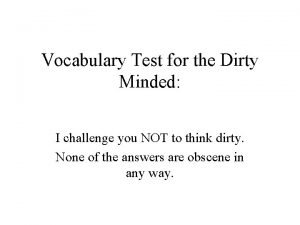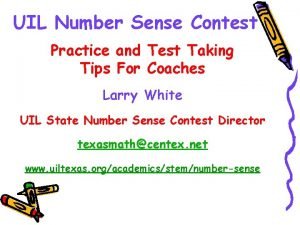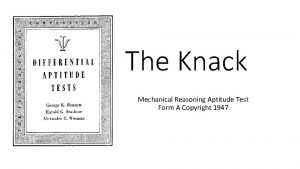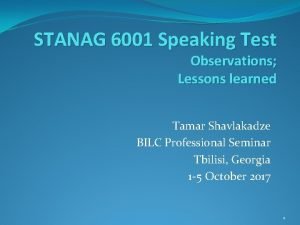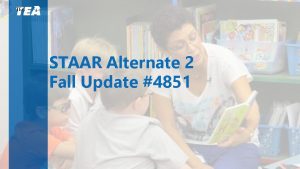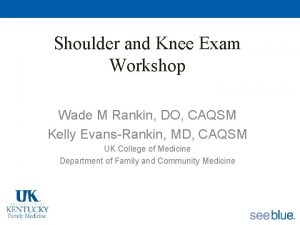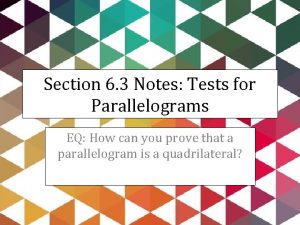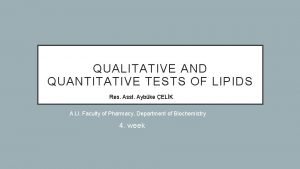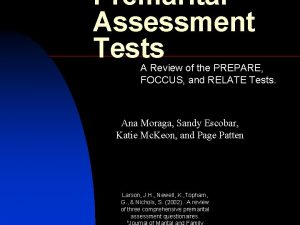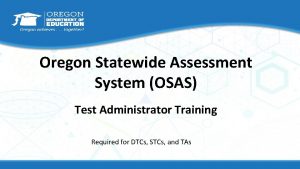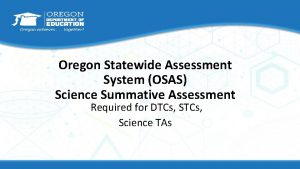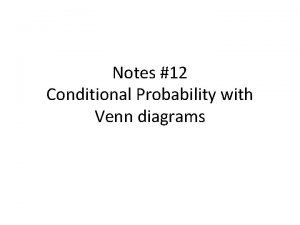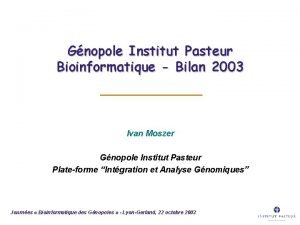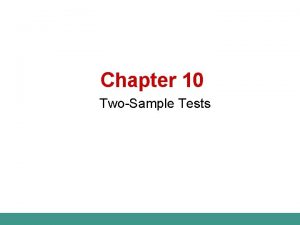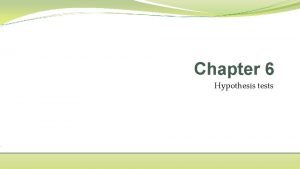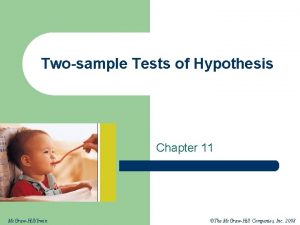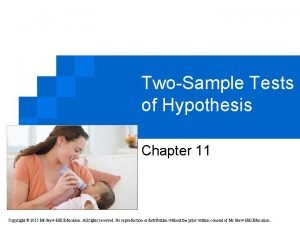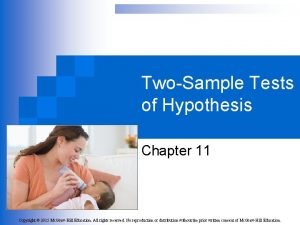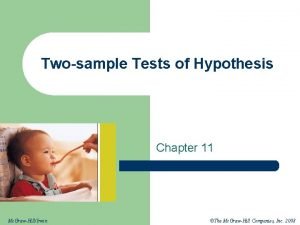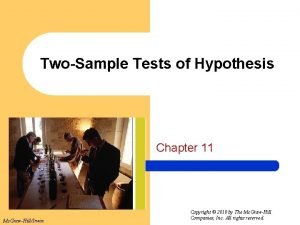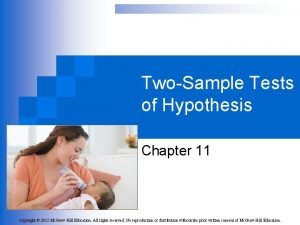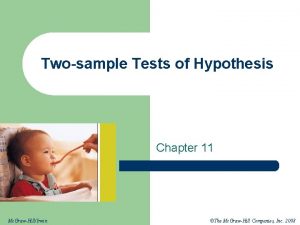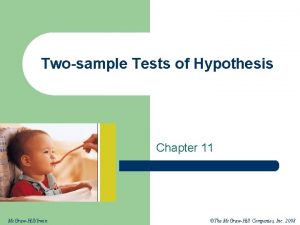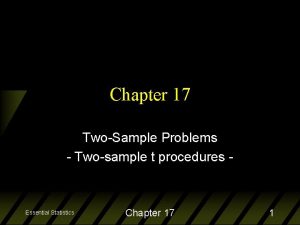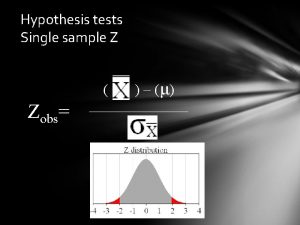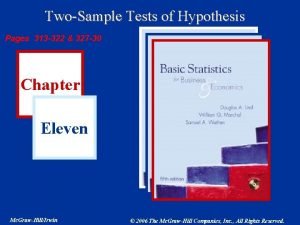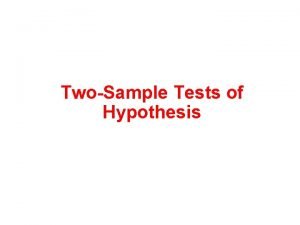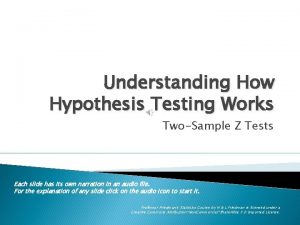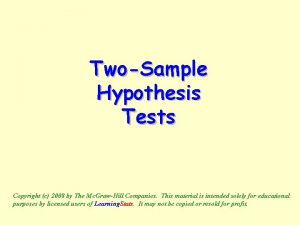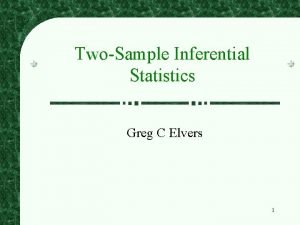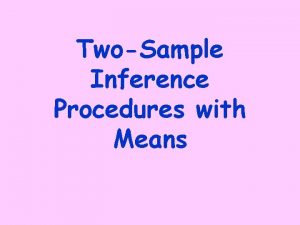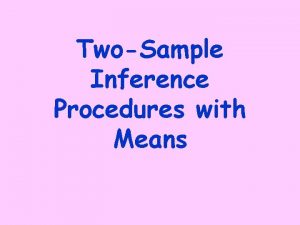Chapter 11 TwoSample Tests of Hypothesis 1 Goals













































- Slides: 45

Chapter 11 Two-Sample Tests of Hypothesis 1

Goals 1. Conduct a test of hypothesis about the difference between two independent population means when both samples have population standard deviation that are known (z) 2. Conduct a test of hypothesis about the difference between two independent population means when both samples have population standard deviation that are not known (t) 3. Conduct a test of hypothesis about the difference between two population proportions (z) 2

Compare The Means From Two Populations § Is there a difference in the mean number of defects produced on the day and the night shifts at Furniture Manufacturing Inc. ? § Comparing two means from two different populations § Is there a difference in the proportion of males from urban areas and males from rural areas who suffer from high blood pressure? § Comparing two proportions from two different populations 3

Two Populations § Two Independent Populations § E-Trade index funds § Merrill Lynch index funds § Two random samples, two sample means § Mean rate of return for E-Trade index funds (10. 4%) § Mean rate of return for Merrill Lynch index funds(11%) § Are the means different? § If they are different, is the difference due to chance (sampling error) or is it really a difference? § If they are the same, the difference between the two sample means should equal zero § “No difference” 4

Two Populations § Two Independent Populations § Plumbers in central Florida § Electricians in central Florida § Two samples, two sample means § Mean hourly wage rate for plumbers ($30) § Mean hourly wage rate for electricians ($29) § Are the means different? § If they are different, is the difference due to chance (sampling error) or is it really a difference? § If they are the same, the difference between the two sample means should equal zero § “No difference” 5

Distribution Of Differences In The Sample Means 6

Theory Of Two Sample Tests: § Take several pairs of samples § Compute the mean of each § Determine the difference between the sample means § Study the distribution of the differences in the sample means § If the mean of the distribution of differences is zero: § This implies that there is no difference between the two populations § If the mean of the distribution of differences is not equal to zero: § We conclude that the two populations do not have the same population parameter (example: mean or proportion) 7

Theory Of Two Sample Tests: § If the sample means from the two populations are equal: § The mean of the distribution of differences should be zero § If the sample means from the two populations are not equal: § The mean of the distribution of differences should be either: § Greater than zero or § Less than zero 8

Normal Distributions § Remember from chapter 9: § Distribution of sample means tend to approximate the normal distribution when n ≥ 30 § For independent populations, it can be shown mathematically that: § Distribution of the difference between two normal distributions is also normal § The standard deviation of the distribution of the difference is the sum of the two individual standard deviations 9

Test Of Hypothesis About The Difference Between Two Independent Population Means (population standard deviation known) § • • • Same five steps: Step 1: State null and alternate hypotheses Step 2: Select a level of significance Step 3: Identify the test statistic (z) and draw Step 4: Formulate a decision rule Step 5: Take a random sample, compute the test statistic, compare it to critical value, and make decision to reject or not reject null and hypotheses • Fail to reject null • Reject null and accept alternate § Assumptions & Formulas 10

Formulas Two Independent Pop. Means (population standard deviation known) § Standard Deviation of the Distribution of Differences Assumptions: 1. Two populations must be independent (unrelated) 2. Population standard deviation known for both 3. Both distributions are Normally distributed 11

Example 1: Comparing Two Populations § Two cities, Bradford and Kane are separated only by the Conewango River § The local paper recently reported that the mean household income in Bradford is $38, 000 from a sample of 40 households. The population standard deviation (past data) is $6, 000. § The same article reported the mean income in Kane is $35, 000 from a sample of 35 households. The population standard deviation (past data) is $7, 000. § At the. 01 significance level can we conclude the mean income in Bradford is more? 12

Example 1: Comparing Two Populations § We wish to know whether the distribution of the differences in sample means has a mean of 0 § The samples are from independent populations § Both population standard deviations are known 13

Example 1: Comparing Two Populations § Step 1: State null and alternate hypotheses § H 0: µB ≤ µK , or µB = µK § H 1: µ B > µ K § Step 2: Select a level of significance § =. 01 (one-tail test to the right) § Step 3: Identify the test statistic and draw § Both pop. SD known, we can use z as the test statistic § Critical value . 01 yields. 49 area, z = 2. 33 14

Example 1: Comparing Two Populations § Step 4: Formulate a decision rule § If z is greater than 2. 33, we reject H 0 and accept H 1, otherwise we fail to reject H 0 § Step 5: Take a random sample, compute the test statistic, compare it to critical value, and make decision to reject or not reject null and hypotheses 15

Example 1: Comparing Two Populations § Because 1. 98 is not greater than 2. 33, we fail to reject H 0 § We can not conclude that the mean income in Bradford is more than the mean income in Kane § The p-value (table method) is: P(z ≥ 1. 98) =. 5000 -. 4761 =. 0239 § This is more area under the curve associated with zscore of 2. 33 than for alpha § We conclude from the p-value that H 0 should not be rejected § However, there is some evidence that H 0 is not true 16

Test Of Hypothesis About The Difference Between Two Independent Population Means (population standard deviation not known) § • • • Same five steps: Step 1: State null and alternate hypotheses Step 2: Select a level of significance Step 3: Identify the test statistic (t) and draw Step 4: Formulate a decision rule Step 5: Take a random sample, compute the test statistic, compare it to critical value, and make decision to reject or not reject null and hypotheses • Fail to reject null • Reject null and accept alternate § Assumptions & Two Formulas 17

Assumptions necessary: 1. Sample populations must follow the normal distribution 2. Two samples must be from independent (unrelated) populations 3. The variances & standard deviations of the two populations are equal § Two Formulas 1. Pooled variance 2. T test statistic 18

Formulas Two Independent Population Means (population standard deviation not known) Degrees of Freedom = 2 19

Pooled Variance § The two sample variances are pooled to form a single estimate of the unknown population variance § A weighted mean of the two sample variances § The weights are the degrees of freedom that form each sample § Why pool? § Because if we assume the population variances are equal, the best estimate will come from a weighted mean of the two variances from the two samples 20

Example 2: Comparing Two Populations § § § A recent EPA study compared the highway fuel economy of domestic and imported passenger cars A sample of 15 domestic cars revealed a mean of 33. 7 MPG with a standard deviation of 2. 4 MPG A sample of 12 imported cars revealed a mean of 35. 7 mpg with a standard deviation of 3. 9 At the. 05 significance level can the EPA conclude that the MPG is higher on the imported cars? Assume: 1. Samples are independent 2. Population standard deviations are equal 3. Distributions for samples are normal 21

Example 2: Comparing Two Populations § Step 1: State null and alternate hypotheses § H 0: µ D ≥ µ I § H 1: µ D < µ I § Step 2: Select a level of significance § =. 05 (One-tail test to the left) § Step 3: Identify the test statistic and draw § Pop. SD not known, so we use the t distribution § df = 15 + 12 – 1 = 25 § One-tail test with =. 05 § Critical Value = -1. 708 22

Example 2: Comparing Two Populations § Step 4: Formulate a decision rule § If our t < -1. 708, we reject H 0 and accept H 1, otherwise we fail to reject H 0 § Step 5: Take a random sample, compute the test statistic, compare it to critical value, and make decision to reject or not reject null and hypotheses § We must make the calculations for: 1. Pooled Variance 2. t-value test statistic 23

Example 2: Step 5: Compute 24

Example 2: Step 5: Conclude § Because -1. 64 in not less than our critical value of -1. 708, we fail to reject H 0 § There is insufficient sample evidence to claim a higher MPG on the imported cars § The EPA cannot conclude that the MPG is higher on the imported cars 25

Proportion § The fraction, ratio, or percent indicating the part of the sample or the population having a particular trait of interest § Example: § A recent survey of Highline students indicated that 98 out of 100 surveyed thought that textbooks were too expensive § The sample proportion is § 98/100 §. 98 § 98% § The sample proportion is our best estimate of our population proportion 26

Two Sample Tests of Proportions § We investigate whether two samples came from populations with an equal proportion of successes ( U = M) § Assumptions: 1. The two populations must be independent of each other 2. Experiment must pass all the binomial tests 27

Test Of Hypothesis About The Difference Between Two Population Proportions § • • • Same five steps: Step 1: State null and alternate hypotheses Step 2: Select a level of significance Step 3: Identify the test statistic (z) and draw Step 4: Formulate a decision rule Step 5: Take a random sample, compute the test statistic, compare it to critical value, and make decision to reject or not reject null and hypotheses • Fail to reject null • Reject null and accept alternate § Two Formulas 28

Formulas (Two Sample Tests of Proportions) 29

Example 3: Two Sample Tests of Proportions § Are unmarried workers more likely to be absent from work than married workers ( m < u )? § A sample of 250 married workers showed 22 missed more than 5 days last year § A sample of 300 unmarried workers showed 35 missed more than 5 days last year § =. 05 § Assume all binominal tests are passed 30

Example 3: Two Sample Tests of Proportions § Step 1: State null and alternate hypotheses § H 0: m ≥ u § H 1: m < u § Step 2: Select a level of significance § =. 05 • Step 3: Identify the test statistic and draw § Because the binomial assumptions are met, we use the z standard normal distribution § =. 05 . 45 z = -1. 65 (one-tail test to the left) • Step 4: Formulate a decision rule § If the test statistic is less than -1. 65, we reject H 0 and accept H 1, otherwise, we fail to reject H 0 31

Example 3: Two Sample Tests of Proportions • Step 5: Take a random sample, compute the test statistic, compare it to critical value, and make decision to reject or not reject null and hypotheses 32

Example 3: Two Sample Tests of Proportions § Step 5: Conclude § Because -1. 1 is not less than -1. 65, we fail to reject H 0 § We cannot conclude that a higher proportion of unmarried workers miss more than 5 days in a year than do the married workers § The p-value (table method) is: § P(z > 1. 10) =. 5000 -. 3643 =. 1457 §. 1457 >. 05, thus: fail to reject H 0 33

Goals 4. Understand the difference between dependent and independent samples 5. Conduct a test of hypothesis about the mean difference between paired or dependent observations 34

Understand The Difference Between Dependent And Independent Samples § Independent samples are samples that are not related in any way § Dependent samples are samples that are paired or related in some fashion 35

Dependent Samples § The samples are paired or related in some fashion: § 1 st Measurement of item, 2 nd measurement of item § If you wished to buy a car you would look at the same car at two (or more) different dealerships and compare the prices (1 price, 2 price) § Before & After § If you wished to measure the effectiveness of a new diet you would weigh the dieters at the start and at the finish of the program (1 weight, 2 weight) 36

Distribution Of The Differences In The Paired Values § Follows Normal Distribution § If the paired values are dependent, be sure to use the dependent formula, because it is a more accurate statistical test than the formula 11 -3 in our textbook § Formula 11 -7 helps to: § Reduce variation in the sampling distribution § Two kinds of variance (variation between 1 st & 2 nd categories for paired values, &, variation between values) are reduced to only one (variation between 1 st & 2 nd categories for paired values) § Reduced variation leads to smaller standard error, which leads to larger test statistic and greater chance of rejecting H 0 § DF will be smaller 37

Test Of Hypothesis About The Mean Difference Between Paired Or Dependent Observations Make the following calculations when the samples are dependent: mwhere d is the difference mwhere is the mean of the differences m is the standard deviation of the differences mn is the number of pairs (differences)

EXAMPLE 4 m. An independent testing agency is comparing the daily rental cost for renting a compact car from Hertz and Avis m. At the. 05 significance level can the testing agency conclude that there is a difference in the rental charged? m. A random sample of eight cities revealed the following information

EXAMPLE 4 Miami Seattle continued 41 39 46 50

EXAMPLE 4 continued m. Step 1: m. Step 2: m m. Step =. 05 3: m Use m. Step m If t because n < 30, df = 7, critical value = 2. 365 4: t < -2. 365 or t > 2. 365, H 0 is rejected and H 1 accepted, otherwise, we fail to reject H 0

Example 4 continued City Hertz Avis d d 2 Atlanta 42 40 2 4 Chicago 56 52 4 16 Cleveland 45 43 2 4 Denver 48 48 0 0 Honolulu 37 32 5 25 Kansas City 45 48 -3 9 Miami 41 39 2 4 Seattle 46 50 -4 16 8 78 Totals

Example 4 continued

Example 4 continued m Step 5: m Because 0. 894 is less than the critical value, do not reject the null hypothesis m There is no difference in the mean amount charged by Hertz and Avis

Summarize Chapter 11 1. Conduct a test of hypothesis about the difference between two independent population means when both samples have 30 or more observations 2. Conduct a test of hypothesis about the difference between two independent population means when at least one sample has less than 30 observations 4. Conduct a test of hypothesis about the difference between two population proportions 5. Understand the difference between dependent and independent samples 6. Conduct a test of hypothesis about the mean difference between paired or dependent observations 45
 Strategic goals tactical goals operational goals
Strategic goals tactical goals operational goals Strategic goals tactical goals operational goals
Strategic goals tactical goals operational goals Ace different iq tests but still
Ace different iq tests but still Define null hypothesis
Define null hypothesis Null and alternative hypothesis statistics
Null and alternative hypothesis statistics Alternative hypothesis
Alternative hypothesis Weakness of protoplanet hypothesis
Weakness of protoplanet hypothesis General goals and specific goals
General goals and specific goals Examples of generic goals and product-specific goals
Examples of generic goals and product-specific goals Chapter 23 specimen collection and diagnostic testing
Chapter 23 specimen collection and diagnostic testing Chapter 20 more about tests and intervals
Chapter 20 more about tests and intervals Chapter 24 diagnostic tests and specimen collection
Chapter 24 diagnostic tests and specimen collection Chapter 8 hypothesis testing
Chapter 8 hypothesis testing Chapter 7 hypothesis testing with one sample answers
Chapter 7 hypothesis testing with one sample answers A repetition of, or return to, criminal behavior
A repetition of, or return to, criminal behavior Observation research method
Observation research method Wigan lea mental maths
Wigan lea mental maths Tds apes
Tds apes Romberga tests
Romberga tests Are u dirty minded quiz
Are u dirty minded quiz Uil number sense
Uil number sense Uil mathematics practice test
Uil mathematics practice test Which shaft will turn most slowly
Which shaft will turn most slowly Shrek ordinary world
Shrek ordinary world Parametric test and non parametric test
Parametric test and non parametric test Stanag 6001 test
Stanag 6001 test Tea dccr manual
Tea dccr manual Simple recall type questions
Simple recall type questions Yergason test
Yergason test 6-3 practice tests for parallelograms
6-3 practice tests for parallelograms Rorschach tests definition psychology
Rorschach tests definition psychology Qualitative tests for lipids lab report
Qualitative tests for lipids lab report Provincial achievement tests
Provincial achievement tests Luminol blood test
Luminol blood test Premarital tests or assessments
Premarital tests or assessments Prayer before big exam
Prayer before big exam Tide osas
Tide osas Osas sample test
Osas sample test How to find the probability of a given b
How to find the probability of a given b Hypochromic anemia
Hypochromic anemia Nonparametric tests
Nonparametric tests 6-3 tests for parallelograms answers
6-3 tests for parallelograms answers Achievement vs aptitude tests psychology
Achievement vs aptitude tests psychology Pros and cons of sternberg's triarchic theory
Pros and cons of sternberg's triarchic theory Eqao grade 3 practice test math
Eqao grade 3 practice test math Tests paramétriques
Tests paramétriques









